There are five different types of plants that you will want to add to your pond to provide beauty and help you achieve an ecological balance in your water garden.
Submerged plants such as Anacharis, Vallisneria, Cabomba, Hornwort and Red Ludwigia remove nutrients from the water so algae can’t thrive. Submerged plants do not need soil. Just plant them in one-gallon pots or plant baskets filled with pea gravel and place them in the bottom of your pond. Or purchase plant anchors with your plant order, and simply wrap the weights around the bunch of plants and they will sink to the bottom of the pond.
Water Hyacinth, Water Lettuce, Frog Bit, Parrot’s Feather and Azolla are all members of the floating plant family. Floating plants are very useful in keeping the pond water clean and clear. These are simple plants that free-float and do not need to be potted. You simply toss them into the water garden where they are extremely beneficial to the pond. Floating plants shade the surface and with their roots dangling in the water they pull nutrients from the water essentially starving the algae. They tend to be quite prolific and provide hiding places for baby fish and other water garden inhabitants.
Otherwise known as water lilies, they grow in pots placed 12 to 36 inches deep and have foliage and flowers that bloom on top of the water’s surface. Water lilies provide shade for the fish and add coverage to the water’s surface. Water lilies are available in many different colors and sizes.
Lotus are also considered a hardy water plant that can also be planted deep in your pond and its flowers and leaves will help provide shade and coverage.
Plants such as the hardy canna (Thalia dealbata) grow in mud or 8 to 12 inches deep in the water. Arrange them on platform shelves on the edge of your pond to conceal the water garden’s artificial edges. Plant bog and marginal plants in plastic pots, then place the pot under the water and let the plants grow in the open air. When the plants are young, use care and gradually lower them deeper as the plant matures.
Bog Plants and Marginal Plants
Marginal and bog plants grow in damp soil just outside a pond. They are good transition plants between land and water. Some tolerate completely waterlogged ground and others will not tolerate more than moist soil, check each plant’s requirements carefully.
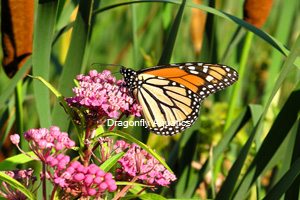 Attracting butterflies to your backyard water feature is easy. It's another one of life's simple pleasures that all gardeners enjoy. Some of the plants that will attract butterflies to your pond are:
Attracting butterflies to your backyard water feature is easy. It's another one of life's simple pleasures that all gardeners enjoy. Some of the plants that will attract butterflies to your pond are:
"Habitat loss is the leading cause of species endangerment and extinction. Backyards are now playing an important role in wildlife conservation. You can help to reduce the negative effects of habitat loss by landscaping with native plants and turning your backyard into a wildlife oasis."
A wildlife-friendly landscape is composed of four essential items:
1) Food 2) Water 3) Shelter or Cover 4) A Place to Raise Young
Creating a habitat in your own backyard is easy. "Choose native plants to your area, both surrounding your pond and in the pond. Explore a nearby wetland to familiarize yourself with its environmental conditions and plant diversity - the goal is to mimic a natural area. To provide the best habitat for a variety of wildlife, choose trees, shrubs, and herbaceous plants with different attributes. When selecting plants, choose varieties that will provide resources and shelter at different times of the year."
Water gardens are a natural place for attracting butterflies. Butterflies will first be attracted to your pond by the flowering bog plants, sip on the nectar and then perch on moist rocks and mossy areas to get a drink. I could spend hours on my bench by my pond, watching the different species fluttering about. If only I had more time to do so!
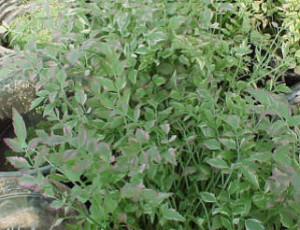 Variegated Water Celery, (Oenanthe javanica 'flamingo') is a great plant for along edges of your water feature, draping down a waterfalls or planted in a stream bed. You can also contain it in a bio-filter or upper pond and then it will grow to trail over your falls.
Variegated Water Celery, (Oenanthe javanica 'flamingo') is a great plant for along edges of your water feature, draping down a waterfalls or planted in a stream bed. You can also contain it in a bio-filter or upper pond and then it will grow to trail over your falls.
Its variegated leaves of light green,white and pink offer a colorful plant for your pond. Its also referred to as rainbow water parsley. It is also a suitable plant for a container water garden. During the heat of the summer the red color in the leaves will fade to a light pink color but return again in the fall. Variegated Water Celery should be located in sun to part shade in moist soil or water to 2 inches deep. Its height averages about 6 inches. Hardy in zones 5-11. This variety of water celery isn't as aggressive as its mother plant, water parsley (Oensnthe sarmentosa) which sometimes grows too quickly and can cover a small pond in a single summer.
Buy Variegated Water Celery, hardy bog plant here.
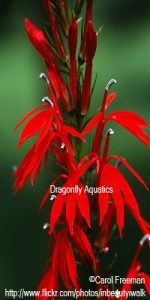 Cardinal flowers are known for their intense bright red flowers, which bloom July through October. Cardinal flowers grow best in sun to part shade. Plant it in moist soil or water no more than 3 inches deep. It will spread to about 12 inches. Hardy in Zones 5-11 but will be fine to Zone 3 with snow coverage. A hardy bog plant that will come back each year. It has single stems that can reach up to 3 feet in height with leaves that grow out and up from the stems until the flower spike appears.
Cardinal flowers are known for their intense bright red flowers, which bloom July through October. Cardinal flowers grow best in sun to part shade. Plant it in moist soil or water no more than 3 inches deep. It will spread to about 12 inches. Hardy in Zones 5-11 but will be fine to Zone 3 with snow coverage. A hardy bog plant that will come back each year. It has single stems that can reach up to 3 feet in height with leaves that grow out and up from the stems until the flower spike appears.
This is a popular plant for all water gardens. Whether you place it in shallow water or along the edges of your pond you will enjoy the intense red flowers when they appear. It attracts a lot of hummingbirds, dragonflies and butterflies. A nature loving plant. I consider this a must have in my water garden and look forward to it blooming each year.
Buy cardinal flowers,lobelia cardinalis,hardy bog plant here.
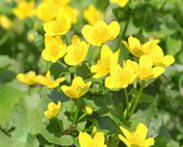 Spring is here and one of the first flowers to awaken in your pond is the Marsh Marigolds. With dark glossy green leaves, bright and cheerful deep yellow flowers, we get excited by the upcoming flourish of flowers in our ponds. Marsh marigolds only bloom in the spring but in some cooler climates they may have a re-bloom. If your summers get extremely hot the leaves may brown and die back but will come back again the following spring. Mine sometimes re-bloom in the fall but not always. It all depends how hot of a summer we get. Hardy in Zones 3 - 7. Its spread is about 10-18 inches and height around 12 inches. Plant in your pond no deeper than 6 inches. It grows well in moist to wet, boggy conditions along the edges of ponds and streams. Great plant for a bog area or along your waterfall.
Spring is here and one of the first flowers to awaken in your pond is the Marsh Marigolds. With dark glossy green leaves, bright and cheerful deep yellow flowers, we get excited by the upcoming flourish of flowers in our ponds. Marsh marigolds only bloom in the spring but in some cooler climates they may have a re-bloom. If your summers get extremely hot the leaves may brown and die back but will come back again the following spring. Mine sometimes re-bloom in the fall but not always. It all depends how hot of a summer we get. Hardy in Zones 3 - 7. Its spread is about 10-18 inches and height around 12 inches. Plant in your pond no deeper than 6 inches. It grows well in moist to wet, boggy conditions along the edges of ponds and streams. Great plant for a bog area or along your waterfall.
If you want to divide this plant it is best done before the flowers appear in the spring or when the plant has gone dormant in the late summer. Divide the root clumps simply by pulling apart and replanting. If you propagate by its seeds you need to do this early summer and they may not bloom until the second year.
Buy Marsh Marigolds,hardy bog plant here.
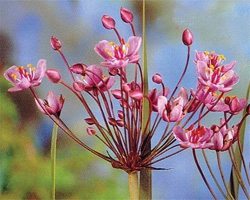 Flowering Rush (Butomus umbellatus) has blossoms that are much more impressive than its foliage, small delicate rose pink flowers. Graceful long green stems and atop a cluster of flowers. The flower is about 5" across ontop of 2' to 4' stems.
Flowering Rush (Butomus umbellatus) has blossoms that are much more impressive than its foliage, small delicate rose pink flowers. Graceful long green stems and atop a cluster of flowers. The flower is about 5" across ontop of 2' to 4' stems.
Flowering Rush usually start to bloom toward the end of spring or early summer. It may even rebloom in the cooler climates. It requires sun to part shade and moist to 3" of water. A very easy aquatic plant to grow. It is zone hardy to at least USDA Zone 3. It prefers colder climates and doesn't seem to like the hot, humid weather.
It is an excellent plant for informal ponds when interplanted with wider-leafed marginals; also grows well in wet spots or a bog area. If placed with a plant such as, Variegated Cattail or Zebra Bullrush, its stunning. Its form and texture lend itself well to a natural looking pond rather than a formal one. The pink flowers pop out amongst the variegated foliage of the cattail or rush. I wouldn't recommend it for a container plant as the water may get too warm for it.
Fertilize it once it begins to grow in the spring. Continue monthly with fertilizer until the plant begins to go dormant in the fall. In the summer after it has stopped flowering is the best time to divide the plant. Dig it up and trim back the foliage. You want to cut the rhizomes into pieces, each one being about 1" to 3" wide. Put the plant back into its space in the pond and replant the new just below the soil. New growth usually appears in about a week.
Buy Flowering Rush,Hardy Bog Plant here.